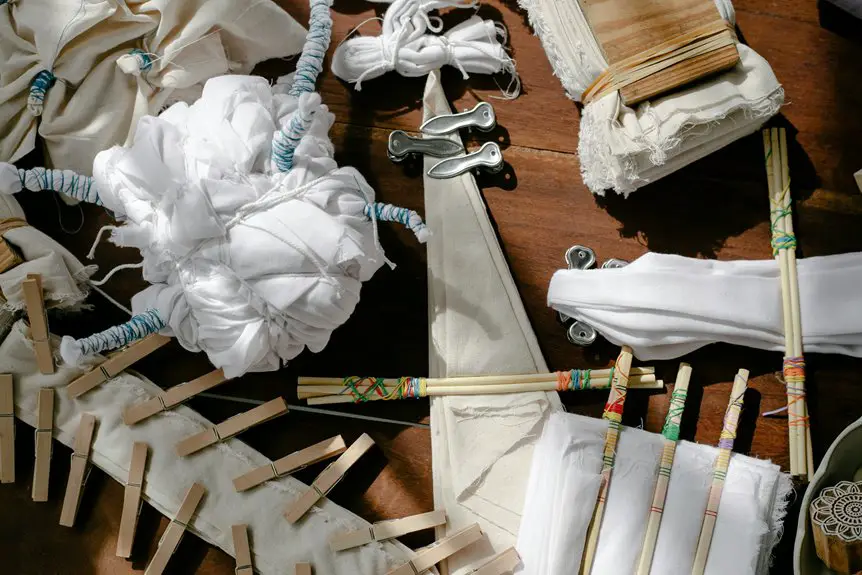Batik fabric isn’t always 100% cotton, though traditional batik often is. Pure cotton batik is soft, breathable, and holds vibrant colors well, making it great for warm climates. However, modern batik may blend cotton with synthetic fibers like polyester to boost durability and wrinkle resistance. You can tell pure cotton by its texture and burn test, but blends offer easy care and affordability. If you want a clearer picture of batik’s materials and benefits, keep exploring.
Table of Contents
Key Takeaways
- Traditional batik fabric is often made from 100% natural cotton for its breathability and dye absorption qualities.
- Pure cotton batik feels soft, breathable, and shows vibrant, long-lasting colors due to excellent dye retention.
- Batik fabric can also be made from silk, rayon, or cotton blends, so not all batik is 100% cotton.
- Synthetic blends are common in modern batik for added durability, wrinkle resistance, and easier care.
- To confirm 100% cotton batik, use sensory tests like touch, weave examination, and burn testing.
Understanding the Origins of Batik Fabric
Although you might associate batik fabric with modern fashion, its origins stretch back centuries to ancient Indonesia.
You’ll find that batik started as a traditional textile art, where artisans used wax-resist dyeing techniques to create intricate patterns. When you look closely, you see that each piece tells a story, reflecting cultural symbols and regional identities.
This method required patience and skill, as the wax applied prevented certain areas from absorbing dye, resulting in stunning designs.
As you explore batik’s history, you’ll realize that it wasn’t just about decoration—it held social and spiritual significance.
Understanding this rich background helps you appreciate batik beyond its beauty, recognizing it as a craft deeply rooted in heritage and tradition.
Common Materials Used in Batik Production
When you look at batik fabrics, you’ll find they’re traditionally made from natural fibers like cotton and silk.
However, synthetic fibers and textile blends are also common in modern production.
Understanding these materials helps you see why not all batik is 100% cotton.
Traditional Batik Fabrics
Many traditional batik fabrics rely on natural fibers, with cotton being the most popular due to its breathability and ability to absorb wax and dye effectively.
When you work with cotton batik, you’ll notice how the fabric holds intricate patterns beautifully, making it ideal for detailed designs.
Besides cotton, silk is also common in traditional batik, prized for its smooth texture and vibrant color retention. You’ll find silk batik often used in special garments or ceremonial attire.
Linen occasionally appears, though less frequently, offering a coarser texture.
These natural fibers let you experience authentic batik craftsmanship, as they interact well with the wax-resist dyeing process.
Synthetic Vs Natural Fibers
Since batik production involves a range of materials, understanding the differences between synthetic and natural fibers can help you choose the right fabric for your project.
Natural fibers like cotton and silk absorb dye well, allowing batik designs to appear vibrant and rich. They’re breathable, comfortable, and durable, making them ideal for traditional batik clothing.
On the other hand, synthetic fibers such as polyester or nylon don’t absorb dye as effectively, which can result in less vivid patterns. However, synthetics often offer greater wrinkle resistance and durability.
When selecting your fabric, consider how the fiber’s properties will affect the batik’s appearance and wearability. Choosing natural fibers usually enhances authenticity and dye quality, but synthetics might suit projects demanding easy care and longevity.
Common Textile Blends
Batik production often incorporates a variety of textile blends to balance aesthetics, durability, and cost. While 100% cotton is traditional, you’ll find blends like cotton-polyester or cotton-rayon common.
These mixes enhance fabric strength and reduce wrinkling, making the batik easier to maintain. Polyester adds durability but might sacrifice breathability, whereas rayon offers a silkier feel but less resilience.
Some artisans also use silk blends for luxury batik, giving you a smooth texture and vibrant color absorption.
When you choose batik, consider the fiber content based on your needs—pure cotton for comfort and authenticity, or blends for practicality and longevity. Understanding these options helps you select batik fabric that fits both your style and functional preferences.
Characteristics of 100% Cotton Batik Fabric
Cotton’s natural softness and breathability make it a popular choice for batik fabric. When you handle 100% cotton batik, you’ll notice its smooth texture and lightweight feel, which keeps you comfortable even in warm weather.
This fabric absorbs dye exceptionally well, allowing vibrant and detailed batik patterns to come alive with clarity. You’ll also appreciate its durability; cotton fibers withstand repeated washing without losing shape or color intensity.
Plus, cotton batik breathes, reducing moisture buildup and keeping your skin cool. Unlike synthetic blends, it feels natural against your skin and ages gracefully, often becoming softer over time.
If you want a fabric that combines comfort, vivid design, and longevity, 100% cotton batik is a reliable and stylish choice.
How to Identify Pure Cotton Batik
Understanding the qualities of 100% cotton batik helps you appreciate why identifying pure cotton fabric matters.
To spot genuine cotton batik, trust your senses and a few simple tests.
- Touch the fabric – Pure cotton feels soft and breathable, never plasticky or stiff.
- Check the weave closely – Cotton threads are tightly woven and slightly uneven, unlike synthetic blends.
- Perform a burn test – Cotton burns quickly with a paper-like smell; synthetics melt or smell chemical.
- Observe color vibrancy – Cotton batik dyes soak deeply, producing rich, lasting colors that don’t easily fade.
Advantages of Choosing Cotton Batik for Clothing
When you choose cotton batik for your clothing, you get a fabric that’s comfortable, durable, and breathable.
Cotton’s natural fibers allow air to circulate, keeping you cool in warm weather and cozy when it’s cooler. You’ll appreciate how soft the fabric feels against your skin, making it perfect for daily wear.
Cotton batik also absorbs moisture well, helping you stay dry and fresh throughout the day. Its durability means your favorite batik pieces will hold up through repeated washes without losing their vibrant patterns or shape.
Plus, cotton is easy to care for, so you won’t spend extra time or effort maintaining your batik clothing.
Choosing cotton batik means enjoying both style and practicality with every wear.
Alternatives to Cotton in Batik Fabrics
You might find batik fabrics made from non-cotton fibers like silk, rayon, or linen, each offering unique textures and qualities.
Blended fabrics combine cotton with synthetics to boost durability and reduce wrinkles.
Understanding these alternatives can help you choose batik that fits your style and care preferences.
Common Non-Cotton Fibers
Batik fabrics don’t always rely on cotton; several other fibers offer unique qualities that can enhance the textile’s look and feel.
When exploring non-cotton options, you’ll find materials that bring distinct textures and durability to the fabric.
- Silk – Offers a luxurious sheen and smooth touch, perfect for elegant batik pieces.
- Rayon – Mimics cotton’s softness but drapes more fluidly, adding grace to your garment.
- Linen – Gives a crisp texture and breathability, ideal for warm climates.
- Polyester – Adds strength and wrinkle resistance, making batik easier to care for.
Each fiber changes how batik feels and performs, letting you choose the perfect fabric for your style and needs.
Blended Fabric Benefits
Although pure cotton remains popular, blended fabrics offer compelling advantages that make them a smart alternative for batik textiles.
When you choose blends, you get enhanced durability and wrinkle resistance, which means your batik fabric looks fresher for longer and requires less maintenance.
Blends often combine cotton with fibers like linen or rayon, improving breathability while adding a smoother texture or slight sheen.
You’ll also appreciate how blended fabrics can be more cost-effective without sacrificing comfort.
Plus, these fabrics tend to hold dye better, so the intricate batik patterns stay vibrant after multiple washes.
Synthetic Material Uses
When exploring alternatives to cotton, synthetic materials stand out for their versatility and durability in batik fabrics.
You’ll find that these fabrics often resist wrinkles and shrinkage better than pure cotton, making them easier to care for. Plus, synthetic fibers can offer vibrant color retention, enhancing the batik’s intricate designs.
Here’s why you might consider synthetics:
- They dry quickly, perfect if you’re always on the go.
- They resist stains and fading, keeping your batik looking fresh.
- They’re generally more affordable, saving you money.
- They provide a lightweight feel, ideal for warmer climates.
Frequently Asked Questions
How Should I Properly Wash Batik Fabric to Maintain Its Quality?
Over 70% of batik fabrics fade if washed improperly. To maintain quality, you should hand wash in cold water with mild detergent, avoid wringing, and air dry away from direct sunlight to preserve colors and texture.
Can Batik Fabric Be Used for Home Décor Projects?
You can definitely use batik fabric for home décor projects. Its vibrant patterns add unique charm to pillows, curtains, or table runners. Just remember to handle it gently to preserve its colors and texture over time.
What Are the Environmental Impacts of Batik Dyeing Processes?
Did you know traditional batik dyeing uses over 50 liters of water per kilogram of fabric? You should know it often involves toxic dyes and waste, so choosing eco-friendly options helps reduce environmental harm considerably.
Are There Any Cultural Significances Tied to Batik Patterns?
You’ll find batik patterns rich with cultural meanings, symbolizing heritage, beliefs, and social status. Each design tells a story or represents local traditions, so you can appreciate the deep cultural significance behind every motif.
How Long Does Batik Fabric Typically Last With Regular Use?
You can expect batik fabric to last several years with regular use, especially if you care for it properly. Hand-waxed patterns stay vibrant longer when you avoid harsh washing and direct sunlight exposure.
- Tetron Fabric for Marine Applications: Durability and Use Cases - June 18, 2025
- Tetron Fabric for Outdoor Furniture: Weather Resistance and Care - June 18, 2025
- Tetron Fabric for Wall Coverings: Style and Application Tips - June 18, 2025



